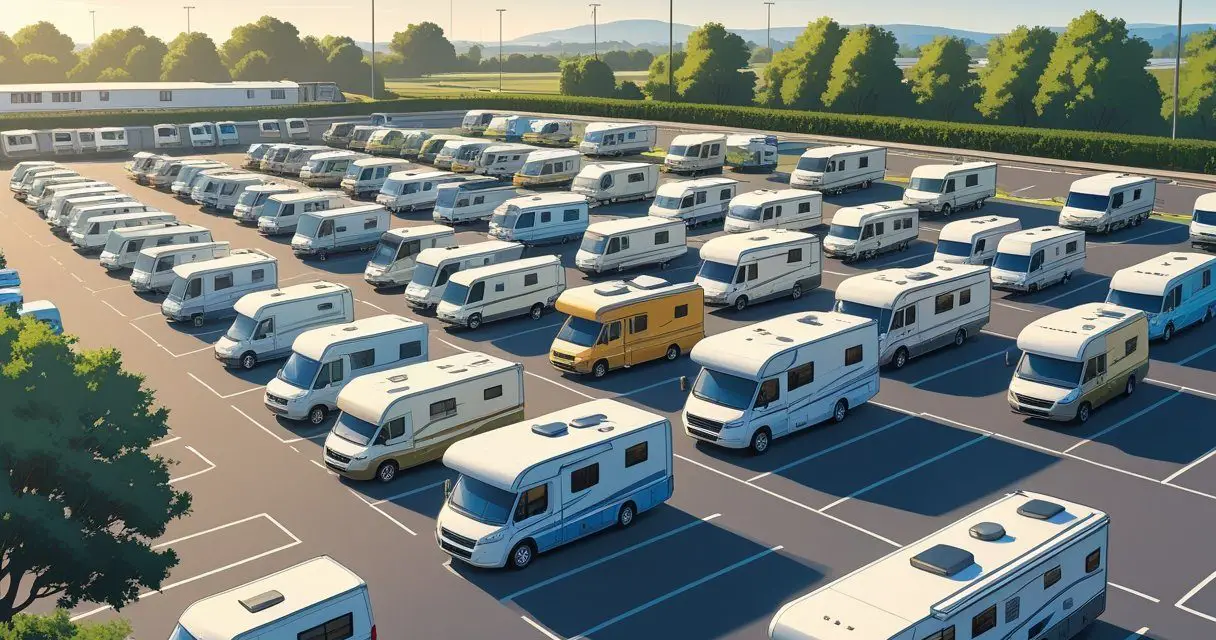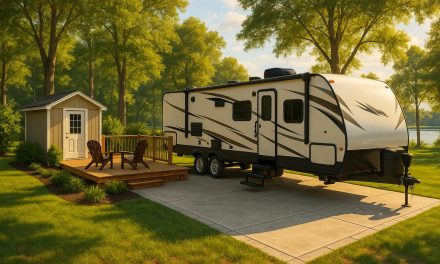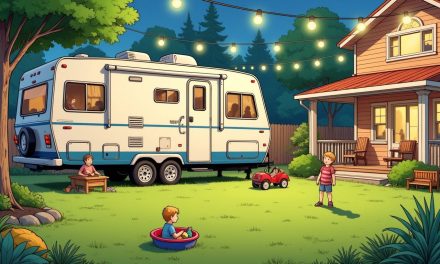Would you like to save this article?
20 Motorhomes Dealers Can’t Sell: Your Guide to Massive RV Discounts in 2025
Ever wondered why some shiny, brand-new motorhomes sit on dealer lots for months? While RV sales dropped 6.9% in 2024 to just 356,518 units, certain models are struggling far worse than others. Dealers are facing mounting floor plan costs, with some units accumulating interest charges for 150+ days on the lot.
The RV market has shifted dramatically since the pandemic boom. Mid-priced motorhomes in the $30,000-$55,000 range saw declines of 15-22% in 2024, leaving dealers desperate to move inventory. You’re about to discover which 20 motorhomes are creating the biggest headaches for dealers nationwide – and where the deepest discounts are hiding.
Understanding which models aren’t selling gives you serious negotiating power. When dealers are stuck paying floor plan interest on aging inventory, they become your best friend at the bargaining table.
1. Thor Windsport – The Awkward Middle Child
The Thor Windsport represents everything wrong with playing it safe in today’s RV market. This mid-tier Class A sits in RV purgatory – too expensive for first-time buyers at around $80,000-$120,000, yet lacking the luxury features that justify stepping up from budget options.
Market Reality Check:
- Average days on lot: 180+ days
- Price reductions: Up to $15,000 off MSRP
- Floor plan costs: $300-500/month per unit
| What’s Wrong | Why It Matters |
|---|---|
| Dated interior styling | Buyers expect modern aesthetics |
| Clunky handling | Poor driving experience for Class A newbies |
| Terrible fuel economy | 6-8 MPG turns off budget-conscious travelers |
You’ll spot Windsports gathering dust because they’re caught between two buyer groups. Smart shoppers either go cheaper or step up to something with real luxury appeal. The result? Dealers quietly shuffling these to auction houses just to free up valuable lot space.
If you can handle the compromises and find one marked down 20-25%, it might work. But remember – there’s probably a good reason it’s been sitting there since last spring.
2. Winnebago Adventurer – When Legends Lose Their Luster
The Winnebago Adventurer once commanded respect in the Class A gas market, but 2025 buyers are walking away unimpressed. Despite the famous Winnebago badge, this coach feels frozen in time with design language that screams early 2000s.
The Numbers Don’t Lie:
- Inventory turnover: 240+ days in many markets
- Depreciation rate: 18-22% in first year
- Dealer incentives: Up to $20,000 cash back
You’ll notice the Adventurer’s struggles immediately when you step inside and see bulky layouts paired with dated color schemes. The ride quality feels like piloting a school bus, and with gas prices climbing, that 6 MPG highway mileage becomes a deal-breaker for most retirees.
According to industry data, over 40% of Adventurer inventory is sitting beyond the typical 90-day sales cycle. Dealers are offering massive trade-in allowances and extended warranties just to move these aging units.
The irony? Winnebago’s reputation actually works against the Adventurer now – buyers expect more from the brand that created the RV industry.
3. Forest River Georgetown 3 Series – Lost in Translation
Forest River designed the Georgetown 3 Series as an “accessible luxury” entry point, but it landed nowhere. At $85,000-$135,000, it’s priced like premium while delivering budget-level materials and finishes.
Why Dealers Are Stuck:
- Floor plan aging: 5-6 months average
- Price compression: Competing with better-equipped rivals
- Quality perception: Materials feel cheap for the price point
You’ll understand the Georgetown 3’s problem within minutes of touring one. The cabinetry feels hollow, the seating lacks support, and the overall fit-and-finish screams “corner-cutting.” Meanwhile, shoppers discover they can get a Tiffin Allegro or Winnebago Vista for similar monthly payments.
Forest River shipped 15% fewer Georgetown units in 2024 compared to 2023, yet dealer lots remain packed with unsold inventory. The math is simple: when buyers can’t see the value, they keep shopping.
Your negotiating power here is enormous. Dealers need these gone before 2026 models arrive, creating opportunities for 30-40% discounts if you’re willing to overlook the mediocre execution.
4. Jayco Alante – The Forgotten Warrior
The Jayco Alante suffers from the worst fate in RV sales – being completely forgettable. This Class A gas coach does everything adequately but nothing exceptionally, leaving it invisible in a crowded marketplace.
Market Position Problems:
- Brand recognition: Low compared to Winnebago/Thor
- Resale values: 15-20% below category average
- Dealer support: Limited promotional push
| Alante Specs | Competitor Advantage |
|---|---|
| 6.8L V10 Ford engine | Same as everyone else |
| 25-35 ft lengths | Standard sizing |
| $90K-$140K pricing | No value differentiation |
You’ll find Alante inventory aging because it offers no compelling reason to choose it over more established alternatives. Jayco’s focus on travel trailers means their motorhome division gets less attention and marketing support.
The challenge for dealers? Explaining why someone should buy an Alante instead of a Winnebago Adventurer or Thor Hurricane at similar pricing. Without a clear answer, these units collect dust.
If you discover an Alante with heavy markdowns, negotiate aggressively. The dealer probably forgot it was there too.
5. Coachmen Leprechaun – Lucky Charms Can’t Save This One
The Coachmen Leprechaun built decades of loyalty, but 2025 buyers aren’t feeling the magic. This Class C suffers from stagnant innovation while competitors leap ahead with modern features and styling.
Reality Check Data:
- Design refresh: None in 5+ years
- Storage efficiency: Below category average
- Price competitiveness: Losing to Thor Four Winds
You’ll immediately notice the Leprechaun’s age problem – interiors that look like they were designed when flip phones were popular. The floor plans waste space, storage solutions feel archaic, and materials haven’t evolved with buyer expectations.
Statistical Surveys reports Class C sales down 12% industry-wide, but the Leprechaun is underperforming even those weak numbers. Dealers report 90+ day inventory even with aggressive pricing.
The brutal truth? You can get a Thor Four Winds or Winnebago Minnie Winnie with more features for less money. That makes the Leprechaun a tough sell unless dealers slash prices to clearance levels.
6. Thor Chateau – Stuck in Reverse
The Thor Chateau represents everything wrong with resting on past success. This Class C has barely evolved since 2015, making it feel ancient compared to rapidly improving competition.
Age-Related Issues:
- Interior design: Unchanged for 8+ years
- Technology integration: Minimal
- Fuel efficiency: No improvement over time
Performance vs. Competition:
| Category | Chateau | Winnebago Minnie | Coachmen Freelander |
|---|---|---|---|
| Fuel Economy | 8-10 MPG | 10-12 MPG | 9-11 MPG |
| Interior Rating | 6/10 | 8/10 | 7/10 |
| Dealer Inventory Days | 180+ | 60-90 | 90-120 |
You’ll spot the Chateau’s problems instantly – upholstery patterns that scream “discount hotel” and handling that feels disconnected from the road. With over 10,000 new 2024 RVs still unsold according to RV Across America, the Chateau represents a significant chunk of that stagnant inventory.
Thor needs to completely reimagine this model or watch dealers continue marking them down just to free up financing capacity for better-selling units.
7. Forest River Sunseeker – Death by a Thousand Trim Levels
The Forest River Sunseeker proves that more options don’t always equal more sales. With dozens of floor plans and trim levels, this Class C creates analysis paralysis for buyers and inventory nightmares for dealers.
The Oversaturation Problem:
- Floor plan variations: 20+ options
- Quality inconsistency: Varies by trim level
- Dealer confusion: Difficulty explaining differences
You’ll experience the Sunseeker’s identity crisis firsthand when touring dealer lots. One unit looks premium with solid finishes, while another feels stripped down despite similar pricing. This inconsistency destroys buyer confidence.
Forest River’s production numbers show the issue – they’re building more Sunseekers than the market demands, flooding dealer lots with inventory that competes against itself. Black Book reports motorhome values up 15.8%, but overproduced models like the Sunseeker aren’t seeing those gains.
The result? Dealers offering massive incentives just to move units and make room for inventory that might actually sell. If you can navigate the confusion and find a well-equipped example at clearance pricing, you might score a deal.
8. Gulf Stream BT Cruiser – The Identity Crisis Mobile
The Gulf Stream BT Cruiser exemplifies the problems with creating categories that don’t exist. Marketed as “Class B+,” it’s too big for van life enthusiasts yet too small for families wanting real living space.
Category Confusion Stats:
- Market segment size: Less than 2% of total RV sales
- Buyer demographics: Unclear target audience
- Resale performance: Poor due to niche appeal
You’ll understand the BT Cruiser’s struggle immediately – it’s stuck between two distinct buyer groups without satisfying either. Van life enthusiasts want true agility, while families need more space than this awkward middle ground provides.
Gulf Stream lacks the brand power of Winnebago or Airstream in the Class B space, making it even harder to justify the premium pricing. Dealers report these units sitting 150+ days with minimal interest.
The math is brutal: Why buy a BT Cruiser when you can get a Winnebago Travato or Thor Sequence with better brand recognition and resale values? Most buyers can’t answer that question, leaving dealers with aging inventory.
9. Thor Axis – The Swiss Army Knife Nobody Asked For
The Thor Axis tries to blend Class A luxury with Class C convenience, creating a “recreational utility vehicle” that satisfies nobody. This unique approach sounds innovative but translates to real-world disappointment.
Design Compromise Data:
- Interior space efficiency: Below both Class A and C averages
- Ride quality: Disappointing for the size
- Price positioning: Class A pricing, Class C experience
| Axis Problems | Buyer Expectations | Reality Delivered |
|---|---|---|
| Smooth Class A ride | Highway comfort | Stiff, noisy experience |
| Spacious interiors | Room to relax | Cramped layouts |
| Value pricing | Fair cost per square foot | Premium pricing |
You’ll immediately notice the Axis feels confused about its identity. The proportions look odd, the interior layouts waste space, and the driving experience disappoints anyone expecting Class A refinement.
Thor pushed hard on marketing but dealers report inventory aging beyond 200 days in many markets. When buyers can get a traditional Class C with more space or a real Class A with better comfort for similar money, the Axis gets passed over.
10. Coachmen Beyond – Premium Pricing, Economy Results
The Coachmen Beyond targets the luxury van market but delivers premium pricing without premium execution. Built on the Ford Transit chassis, it competes with established players like Winnebago Revel and Airstream Interstate – and loses badly.
Market Reality:
- Price range: $130,000-$180,000
- Target demographic: High-income couples
- Actual performance: Poor sales numbers
You’ll quickly see why the Beyond struggles – at $150,000+, buyers expect Airstream-level quality and Winnebago-level reliability. Instead, they get adequate construction with premium pricing that doesn’t match the execution.
Class B sales represent only 5% of the RV market, making it a challenging segment even for established brands. New entrants like the Beyond face uphill battles against buyer loyalty and proven track records.
Dealers report 180+ day inventory cycles with minimal buyer interest. The harsh reality? At Beyond pricing, buyers can get certified pre-owned Airstreams or Winnebago Revels with better resale prospects.
11. Winnebago Solis Pocket – Minimalism Meets Maximum Pricing
The Winnebago Solis Pocket targets minimalist van life enthusiasts but prices itself out of the core demographic. At $90,000+ for basic features, it competes with full-size Class C motorhomes offering significantly more value.
Pricing vs. Features Analysis:
- Base price: $95,000+
- Living space: 60 square feet
- Bathroom: Portable toilet only
- Kitchen: Basic galley setup
You’ll understand the Solis Pocket’s challenge immediately – it’s priced like a luxury product while delivering camping-level amenities. True van life enthusiasts often prefer DIY conversions, while comfort-seekers choose larger rigs.
The van life market is shifting toward either ultra-budget builds or true luxury conversions. The Solis Pocket sits awkwardly in the middle, offering neither the adventure credentials of a DIY build nor the amenities of premium options.
Winnebago discontinued the model, but dealers still have 2024 inventory gathering dust. If you’re committed to the van life concept and can negotiate 40%+ off MSRP, it might work – but expect limited resale appeal.
12. Thor Outlaw – All Show, No Go
The Thor Outlaw combines motorhome living with toy hauler functionality, creating a niche product for a very specific buyer. Unfortunately, that niche is smaller than Thor anticipated, leaving dealers with expensive inventory and few interested customers.
Niche Market Reality:
- Target buyers: RV owners with toys (ATVs, motorcycles)
- Market size: Less than 3% of motorhome sales
- Average transaction: $200,000-$350,000
| Outlaw Features | Buyer Reality | Market Response |
|---|---|---|
| Garage space | Most RVers don’t have toys | Wasted square footage |
| Bold styling | Appeals to limited demographic | Polarizing design |
| Heavy construction | Poor fuel economy | Operating cost concerns |
You’ll immediately notice the Outlaw’s impracticality – that garage space could be additional living area, storage, or bedroom space. For families or couples focused on travel and comfort, it’s completely wasted.
Dealers stocked up during the pandemic boom, expecting adventure-focused buyers to drive sales. Instead, they’re sitting on $2-5 million worth of Outlaw inventory per major dealership with minimal turnover.
The math is unforgiving: Why pay $250,000 for an Outlaw when you can get a luxury Class A and separate toy hauler for similar money with more flexibility?
13. Winnebago Fuse – The Discontinued Disappointment
The Winnebago Fuse promised European-inspired efficiency built on a Ford Transit diesel chassis, but it quietly disappeared from production after failing to find its market. Dealers still have 2024 inventory that refuses to move.
Why It Failed:
- Interior layouts: Too narrow for American preferences
- Price positioning: Too close to larger Class C options
- Marketing support: Minimal from Winnebago
You’ll understand the Fuse’s problems within minutes – the narrow interior feels cramped compared to traditional Class C layouts, storage is limited, and the diesel platform adds complexity without meaningful benefits for most buyers.
Winnebago’s internal data showed poor market response, leading to discontinuation after just a few model years. Now dealers face the challenge of moving discontinued inventory with unknown parts and service support.
Discontinuation creates a death spiral – buyers avoid discontinued models due to resale concerns, forcing dealers to offer deeper discounts that further damage resale perception. If you can negotiate 50%+ off MSRP, it might work as a short-term solution.
14. Holiday Rambler Admiral – The Admiralty of Mediocrity
The Holiday Rambler Admiral should command respect with its maritime-inspired name, but 2025 buyers are staging a mutiny. This Class A gas motorhome feels stuck in 2010 with styling and features that haven’t evolved with the market.
Aging Fleet Problems:
- Design language: 10+ years behind
- Ride quality: Heavy and underpowered feeling
- Technology integration: Minimal
Performance Comparison:
| Category | Admiral | Winnebago Vista | Thor Hurricane |
|---|---|---|---|
| Interior Styling | 4/10 | 7/10 | 6/10 |
| Ride Quality | 5/10 | 7/10 | 6/10 |
| Fuel Economy | 6-8 MPG | 7-9 MPG | 6-9 MPG |
| Days on Lot | 200+ | 90-120 | 120-150 |
You’ll notice the Admiral’s outdated approach immediately – cabinet styles that look like 1990s mobile homes, trim choices that feel cheap, and overall execution that doesn’t justify the $120,000-$180,000 price range.
Holiday Rambler’s parent company REV Group has struggled with motorhome sales as buyers migrate toward more modern alternatives. The Admiral represents everything wrong with not investing in product development.
15. Jayco Redhawk Special Edition – Nothing Special About It
The Jayco Redhawk Special Edition promises enhanced features and styling, but delivers an experience that’s anything but special. This Class C struggles to differentiate itself in an increasingly competitive segment.
Special Edition Reality:
- Added features: Minimal meaningful upgrades
- Price premium: $5,000-$8,000 over base model
- Market response: Poor sales performance
You’ll quickly discover the “Special Edition” marketing doesn’t match reality. The upgrades often amount to different cabinet hardware, upgraded fabrics, and maybe a few electronic additions that don’t fundamentally improve the RV experience.
Jayco’s focus remains heavily on travel trailers, with motorhomes getting less development attention and marketing support. The result? A forgettable product in a segment where standing out is crucial.
Dealers report 180+ day inventory with buyers opting for base Redhawk models or switching to competitors entirely. The price premium for “special” features doesn’t resonate when those features feel arbitrary.
16. Fleetwood Flair – Flare for the Obsolete
The Fleetwood Flair represents everything wrong with legacy thinking in modern RV markets. This entry-level Class A feels frozen in time with styling and features that haven’t meaningfully evolved in years.
Obsolescence Indicators:
- Interior design: Unchanged for 7+ years
- Materials quality: Below current standards
- Price creep: Up 30% without corresponding improvements
You’ll understand the Flair’s struggles immediately – laminate finishes that look cheap, boxy furniture arrangements that waste space, and overall execution that feels like stepping back in time. At $140,000-$200,000, buyers expect modern amenities and styling.
Fleetwood’s market share has declined steadily as buyers choose more contemporary alternatives from Winnebago, Thor, and Tiffin. The Flair’s reputation as a “starter” Class A motorhome becomes a liability when buyers can start with something better.
Dealers are marking down Flair inventory by $20,000-$40,000 just to compete with better-equipped alternatives. If you can handle the dated execution and negotiate aggressively, there might be value – but expect poor resale performance.
17. Entegra Odyssey – The Overpriced Illusion
H2: Entegra Odyssey – The Overpriced Illusion
The Entegra Odyssey creates confusion by pricing itself as a premium product while sharing significant DNA with budget-oriented Jayco models. Buyers quickly discover they’re paying extra for badge engineering rather than meaningful upgrades.
Badge Engineering Problems:
- Shared platform: Same as Jayco Redhawk
- Price premium: $15,000-$25,000 over equivalent Jayco
- Differentiation: Minimal beyond badges and trim
| Feature | Entegra Odyssey | Jayco Redhawk | Price Difference |
|---|---|---|---|
| Chassis | Ford F53 | Ford F53 | N/A |
| Floor Plans | Nearly Identical | Nearly Identical | N/A |
| Base Price | $115,000+ | $95,000+ | $20,000+ |
You’ll spot the Odyssey’s deception during side-by-side comparisons – the layouts, materials, and construction are virtually identical to cheaper Jayco alternatives. Entegra buyers are essentially paying a luxury tax for minimal differentiation.
Thor Industries owns both brands, creating internal competition that confuses dealers and buyers alike. Why would anyone choose an Odyssey when a Redhawk offers 90% of the same experience for significantly less money?
Dealers struggle to justify the premium, leading to inventory aging beyond 180 days and aggressive discount programs that further erode the “premium” positioning.
18: Forest River Rockwood Roo – The Hybrid Nobody Wants
The Forest River Rockwood Roo represents the dying hybrid trailer segment – combining hard-sided trailers with pop-out canvas sections that promise flexibility but deliver compromise. Modern buyers are rejecting this awkward middle ground.
Hybrid Market Decline:
- Segment share: Down 40% since 2020
- Buyer preference: Moving toward full hard-sided units
- Weather protection: Canvas sections vulnerable
You’ll understand the Roo’s fundamental problem immediately – those canvas pop-outs that define the hybrid experience also create its biggest weaknesses. Temperature control issues, moisture problems, and road noise make them feel like camping rather than RVing.
The price gap between hybrids and full travel trailers has narrowed significantly, making it harder to justify the compromises. Why accept canvas walls when you can get hard-sided protection for similar money?
Forest River continues producing Roo models despite declining demand, flooding dealer lots with inventory that sits for 200+ days. The hybrid concept appeals to a shrinking demographic that values compact towing over comfort.
19: Nexus Viper – The Unknown Quantity
The Nexus Viper suffers from the worst problem in RV sales – nobody knows who they are. This Class B+ motorhome enters a crowded market without brand recognition, dealer network, or compelling differentiation.
Brand Recognition Problems:
- Market awareness: Less than 2%
- Dealer network: Limited coverage
- Service support: Questionable long-term
You’ll experience the Viper’s challenges firsthand when trying to research the company, find service locations, or get reliable reviews. In a market where brand trust drives purchasing decisions, anonymity equals death.
The Class B+ segment is already niche, representing less than 5% of motorhome sales. New entrants without established reputations face nearly impossible odds against Winnebago, Thor, and Leisure Travel Vans.
Dealers taking on Nexus products often find themselves stuck with inventory that generates minimal interest. Without brand loyalty, extensive marketing, or standout features, the Viper becomes just another option in an overcrowded market.
20: Coachmen Mirada – The Confused Identity Crisis
The Coachmen Mirada attempts to bridge entry-level and luxury Class A segments but succeeds in satisfying neither. This positioning confusion leaves buyers uncertain about what they’re actually purchasing.
Identity Crisis Symptoms:
- Trim level inconsistency: Huge variation within model line
- Price range spread: $40,000+ between low and high trims
- Quality perception: Unclear value proposition
| Mirada Trim | Price Range | Target Buyer | Actual Appeal |
|---|---|---|---|
| Base Model | $110,000-$130,000 | Budget-conscious | Feels cheap |
| Mid Trim | $140,000-$160,000 | Value seekers | Confused positioning |
| High Trim | $170,000-$190,000 | Luxury buyers | Inadequate features |
You’ll experience the Mirada’s identity problem immediately – base models feel stripped and cheap while high-end versions lack the refinement buyers expect at luxury pricing. The middle trims satisfy nobody completely.
Coachmen’s strategy of offering something for everyone backfires by creating a product line without clear focus. Buyers shopping entry-level Class A motorhomes choose Winnebago Vista or Thor Hurricane, while luxury seekers opt for Tiffin or Newmar.
The result? Inventory aging across all trim levels as dealers struggle to explain who should buy each version.
Key Market Statistics
| Statistic | 2024 Data | 2025 Trend |
|---|---|---|
| Total RV Sales | 356,518 units (-6.9%) | Continued decline expected |
| Motorhome Average Price | $63,540 (+15.8%) | Price increases outpacing demand |
| Days on Dealer Lots | 150+ days average | Extended aging inventory |
| Mid-Range Price Declines | 15-22% in key segments | Buyer resistance to pricing |
Your negotiating power has never been stronger. With dealers facing mounting floor plan costs and aging inventory, you can secure massive discounts on quality motorhomes – if you know which ones to target and which to avoid.
The smart money focuses on discontinued models and overproduced units where dealers need to clear space more than maximize profit. But remember – there’s often a good reason these 20 motorhomes aren’t selling, so buy with your eyes wide open.
SOURCES
- March 2025 RV Sales Report: Final 2024 Numbers & Market Trends
- Q1 2025 Recreational Vehicles Market Update – Black Book
- RV Pricing Trends from 2024 – Will the Shift Continue in 2025?
- Summer 2025 RV Camper Sales – RV Industry Update
- RV Statistics for 2025: Key Insights and Future Trends
- RV Industry Statistics 2025 | ConsumerAffairs
- State of the RV Industry – May 2025 – Statistical Surveys
- Floor Plan Financing Interest Strategies for RV Dealerships
- 20 Motorhomes No One Is Buying (Dealers Are SLASHING Prices) – YouTube





